Vue 路由
懒加载 (推荐使用)
当一个vue项目很大的时候,对于一些“暂时”用不到的组件,我们可以不进行加载,等到用到次组件时再加载。这样可以优化spa应用首次加载白屏情况,也给用户更好的体验。这就是vue路由懒加载。
懒加载的方式
// 方式一: 结合Vue的异步组件和Webpack的代码分析(基本不用)
const User = resolve => { require.ensure(['@/views/User.vue'], () => { resolve(require('@/views/User.vue')) }) };
// 方式二: AMD写法(基本不用)
const User = resolve => require(['@/views/User.vue'], resolve);
// 方式三: 在ES6中, 我们可以有更加简单的写法来组织Vue异步组件和Webpack的代码分割.(常用方法)
const Home = () => import(/* webpackChunkName: "user" */ '../views/User.vue')
路由模式
vue中的路由默认时hash模式,使用 URL 的 hash 来模拟一个完整的 URL,于是当 URL 改变时,页面不会重新加载。如果不想要 hash的模式,我们可以用路由的history 模式,这种模式充分利用 history.pushState API 来完成 URL 跳转而无须重新加载页面。
hash 虽然出现URL中,但不会被包含在HTTP请求中,对后端完全没有影响,因此改变hash不会重新加载页面。
history模式提供了对历史记录进行修改的功能,只是当它们执行修改时,虽然改变了当前的URL,但你浏览器不会立即向后端发送请求。history模式,会出现404 的情况,需要后台配置。
404 错误:
1、hash模式下,仅hash符号之前的内容会被包含在请求中,如 http://www.xxx.com, 因此对于后端来说,即使没有做到对路由的全覆盖,也不会返回404错误;
2、history模式下,前端的url必须和实际向后端发起请求的url 一致,如http://www.xxx.com/book/id 。如果后端缺少对/book/id 的路由处理,将返回404错误。
路由跳转方式
我们可以使用 router-link 标签来实现跳转,如:
<div id="nav">
<router-link to="/">Home</router-link> |
<router-link to="/user">User</router-link>
</div>
<router-view/>
然后通过 router-view 来显示页面。router-link 最终会被渲染为a标签。
router-link 默认会被解析为a标签,如果想让它转换成其他的标签,就需要添加tag属性:
<router-link tag="li" to="/user">User</router-link>
<!-- 此时,`router-link` 就被解析为li标签。 -->
实例:
<!-- <router-link> 相当于 <a>,用于跳转 -->
<router-link to="/">首页</router-link> |
<router-link to="/about">关于</router-link> |
<!-- 新增内容: -->
<router-link to="/user">用户</router-link> |
<router-link to="/news">新闻</router-link> |
<!-- router-link tag属性可以修改编译后的标签 -->
<router-link to="../" tag="button">返回</router-link> |
<!-- router-link replace属性意为"替换(覆盖之前的路径)" -->
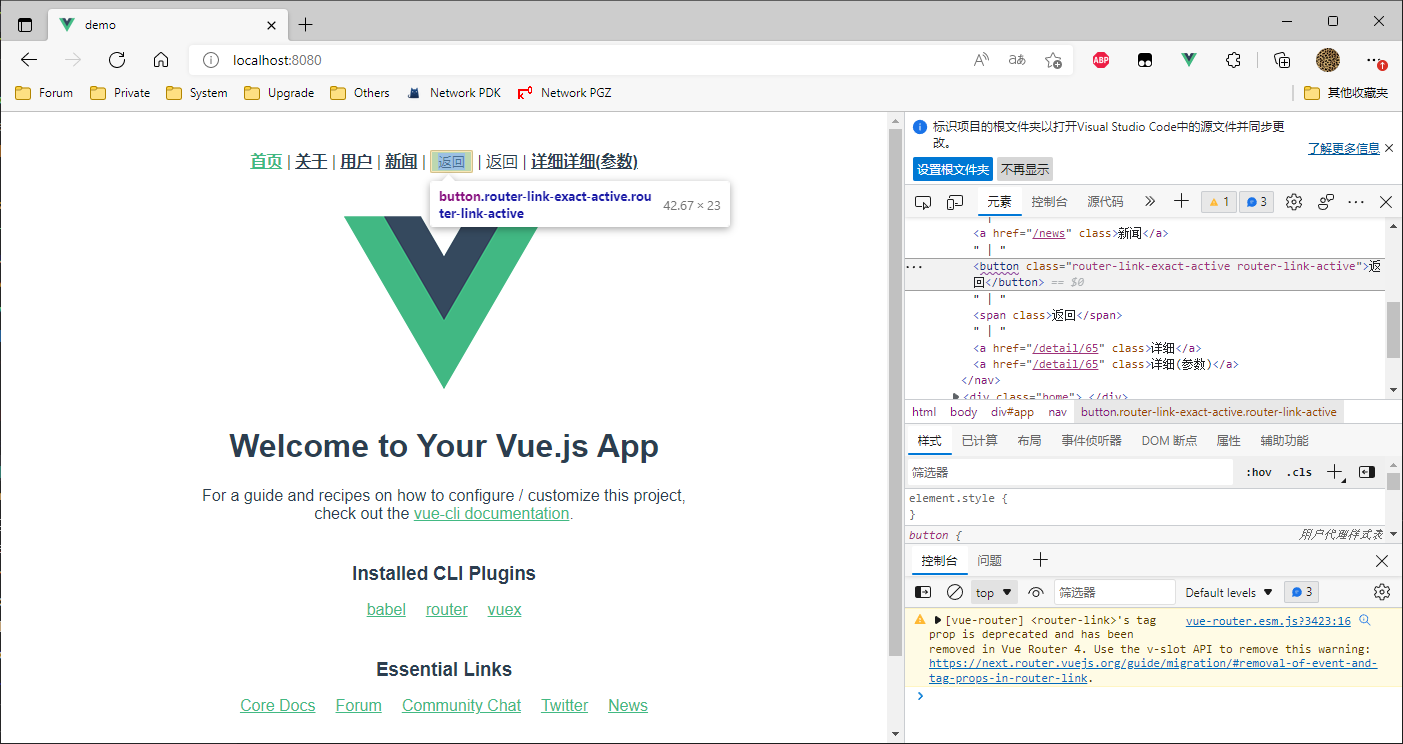
replace 属性
指 “替换” ,即”堆栈“,如在刚打开网页时点击具有 replace 属性的标签,则无法使用浏览器的 “后退” 功能
默认的都为
push()方法,即 ”堆加“
<!-- <router-link> 相当于 <a>,用于跳转 -->
<router-link to="/">首页</router-link> |
<router-link to="/about">关于</router-link> |
<!-- 新增内容: -->
<router-link to="/user">用户</router-link> |
<router-link to="/news">新闻</router-link> |
<!-- router-link tag属性可以修改编译后的标签 -->
<router-link to="../" tag="button">返回</router-link> |
<!-- router-link replace属性意为"替换(覆盖之前的路径)" -->
<!-- 与上面push()追加的不一样,replace属性使浏览器无法后退回上一个页面 -->
<router-link to="/user" tag="span" replace>返回</router-link> |
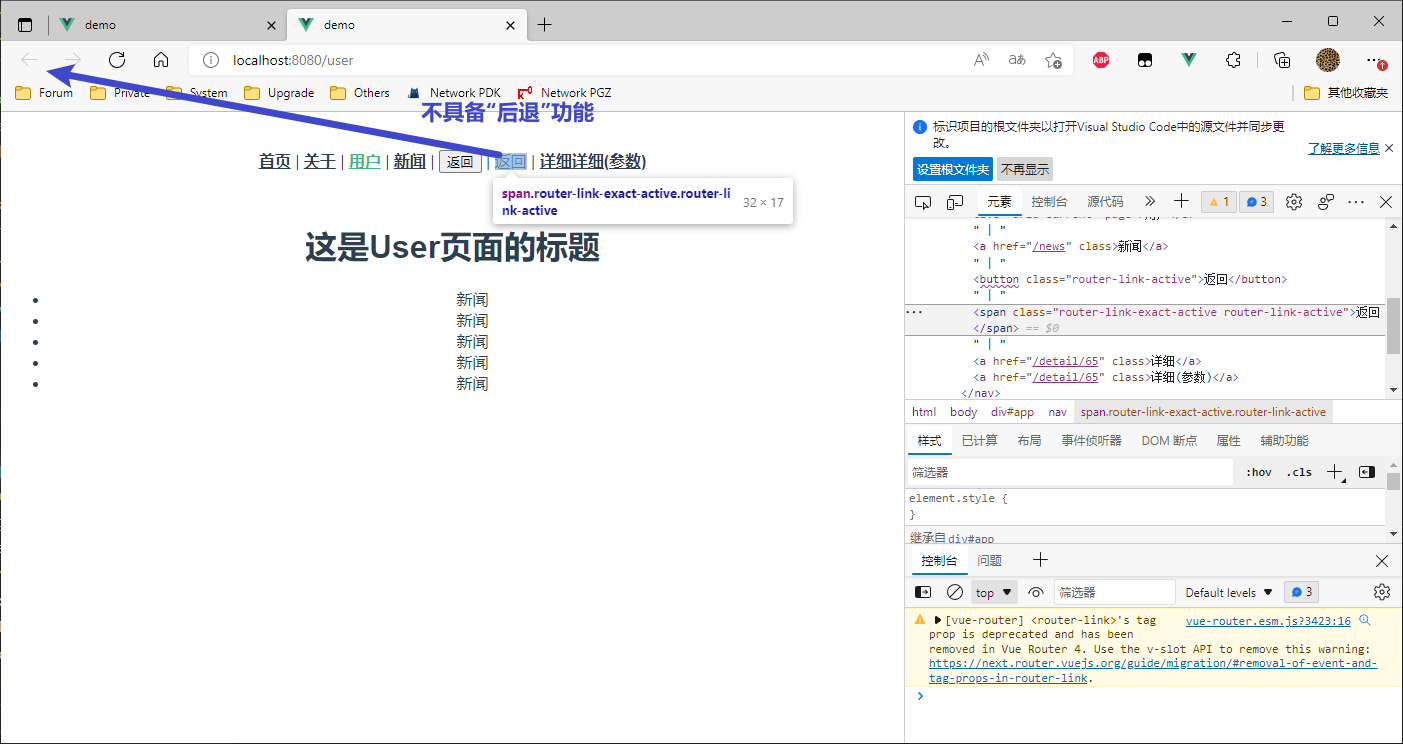
程式导航
我们还有别的方式:
// 简写
this.$router.push('/user')
// 完整的写法
this.$router.push({path: '/user'})
我们除了push,还有go、forward、back这几个来触发不同情况的跳转。
实例:Vue.js
<template>
<div id="app">
<div id="nav">
<button @click="userClick">user</button>
<button @click="aboutClick">about</button>
<button @click="goClick">go-1</button>
<button @click="go1Click">go 1</button>
</div>
<router-view />
</div>
</template>
<script>
export default {
data() {
return {
id1: 65,
id2: 66,
list: [],
};
},
methods:{
userClick(){
// this.$router.push('/user')
this.$router.replace('/user')
},
aboutClick(){
// this.$router.push('/about')
this.$router.replace('/about')
},
goClick(){
// 返回上一页
this.$router.go(-1)
},
go1Click(){
this.$router.go(1)
},
}
</script>
路由命名
当我们给路由命名后:
const router = new VueRouter({
routes: [
{
path: '/user/:userId',
name: 'User', // 对路由进行命名
component: () => import(/* webpackChunkName: "user" */ '../views/User.vue')
}
]
})
携带参数:
router.push({ name: 'user', params: { userId: 123 }})
而在User组件中,可以通过 $route.params.userId 获取到参数:
<div>
用户页{{$route.params.userId}}
</div>
query传参
使用params传参,得到的结果与使用query传参得到的结果有以下区别:
this.$router.push({name: "User", params: {userId: 123}}) // http://localhost:8081/user/123
this.$router.push({name: "User", query: {userId: 123}}) // http://localhost:8081/?userId=123
params参数传参写法相当于在路径直接添加:
//App.vue中:
this.$router.push('/user/12');
// router/index.js中:
path: '/user/:userId',
// User.vue中:
created(){
console.log(this.$route.params.userId); // 获取到用户id12
}
实例:
// router/index.js
import Vue from 'vue'
import VueRouter from 'vue-router'
import Home from '../views/Home.vue'
const News = () => import('../views/News')
Vue.use(VueRouter)
const routes = [
{
path: '/',
name: 'Home',
component: Home
},
{
path: '/about',
name: 'About',
component: () => import(/* webpackChunkName: "about" */ '../views/About.vue')
},
{
path: '/news',
component:News
},
{
path:'/user',
component:() => import('../views/User')
},
{
// path:'/detail/65',
// 动态路由
path:'/detail/:itemId',
component:() => import('../views/Detail')
},
{
path: '/profeil',
component:() => import('../views/Profeil')
}
]
const router = new VueRouter({
mode: 'history',
base: process.env.BASE_URL,
routes
})
export default router
// App.vue
<template>
<div id="app">
<div id="nav">
<!-- 参数 -->
<router-link :to="'/detail/' + id1">手机</router-link> |
<router-link :to="'/detail/' + id2">花洒</router-link> |
<router-link :to="{path: '/detail', query: {userId: 123}}">111</router-link> |
<router-link :to="{path: '/profeil', query: {name: 'zhangsan', age: 25}}">个人中心</router-link>
</div>
<router-view />
</div>
</template>
<script>
export default {
data() {
return {
id1: 65,
id2: 66,
list: [],
};
},
// Detail.vue
<template>
<div>
<h2>详情页</h2>
<!-- 获取商品的详细数据,先回去到商品的id -->
{{getItemId}}
</div>
</template>
<script>
export default {
data () {
return {
itemId:null
}
}
computed:{
getItemId(){
let itemId = this.$route.params.itemId;
this.$data.itemId = itemId
return itemId;
}
}
}
</script>
<style></style>
重定向
// router/index.js
const routes = [
{
path: '/',
redirect: '/home' // 这就是路由的重定向,重新定义跳转路径
},
{
path: '/home', // 改成这个之后,原来的/就没有对用的组件了
component: () => import('@/views/Home.vue')
},
... ...
{
path: '*', // 匹配所有剩余的路由,只要不是上面提及的页面,全部跳转到404页面
component: () => import('@/views/Page404.vue')
}
]
实例:底部Tab栏
创建项目;
jsconfig.json中的compilerOptions配置项里面添加"jsx": "preserve"。
"compilerOptions": {
...
"jsx": "preserve",
...
}
删除components/HelloWorld.vue
删除views/HomeView.vue中的HelloWorld
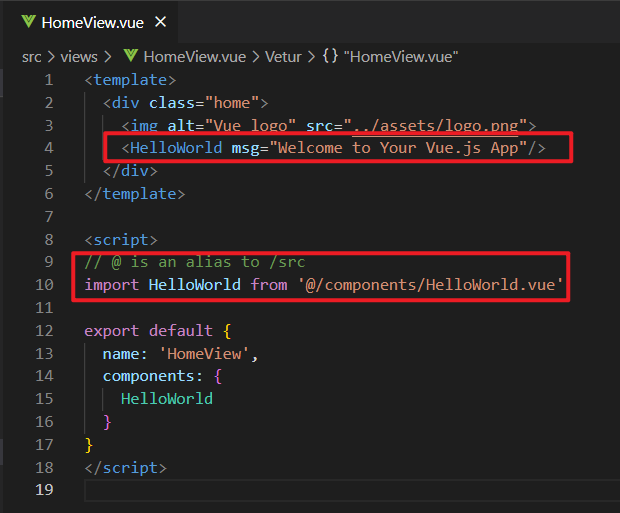
- App.vue 中删除无用代码
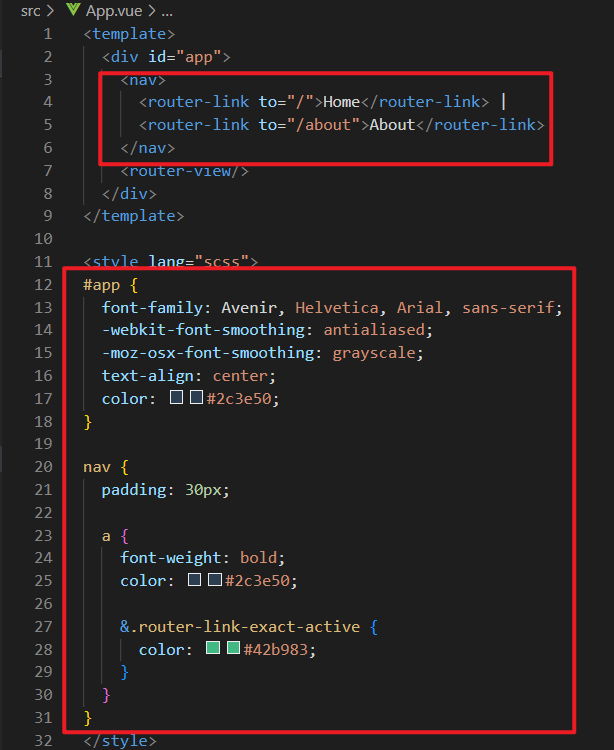
创建 views/List.vue 用来做底栏
<template>
<div>
<h2>List</h2>
</div>
</template>
<script>
export default {
}
</script>
<style>
</style>
- src/router/index.js 配置路由
import Vue from 'vue'
import VueRouter from 'vue-router'
import HomeView from '../views/HomeView.vue'
Vue.use(VueRouter)
const routes = [
{
path: '/',
// name: 'home',
// component: HomeView
// 根路径一般进行重定向:
redirect: '/home'
},
// 设置home的路由
{
path: '/home',
component: HomeView
},
{
path: '/about',
name: 'about',
// route level code-splitting
// this generates a separate chunk (about.[hash].js) for this route
// which is lazy-loaded when the route is visited.
component: () => import(/* webpackChunkName: "about" */ '../views/AboutView.vue')
},
// 配置路由
{
path: '/list',
component: () => import('../views/List.vue')
}
]
const router = new VueRouter({
mode: 'history',
base: process.env.BASE_URL,
routes
})
export default router
- 编写 TabBar 组件
<template>
<div id="tabbar">
<!-- 因为要设置css,所以再加一层div -->
<div class="tabbar-box">
<router-link to="/home">首页</router-link>
<router-link to="/list">列表</router-link>
<router-link to="/about">关于</router-link>
</div>
</div>
</template>
<script>
export default {
}
</script>
<!-- 使用scss样式编写(可嵌套) -->
<style lang="scss">
#tabbar{
.tarbar-box{
display: flex;
.item{
flex: 1; // 指每个容器占一份(即可用空间平均分配)
}
}
}
</style>
- 修改 App.vue
<template>
<div id="app">
<router-view />
<!-- 因为导航栏要显示在下面,所以在下面写 -->
<!-- 3. 使用 -->
<Tabbar></Tabbar>
</div>
</template>
<script>
// 1.导入
import Tabbar from './components/Tabbar.vue'
export default {
// 2.定义(绑定)
components: {
Tabbar
}
}
</script>
<style lang="scss">
</style>
此时效果:
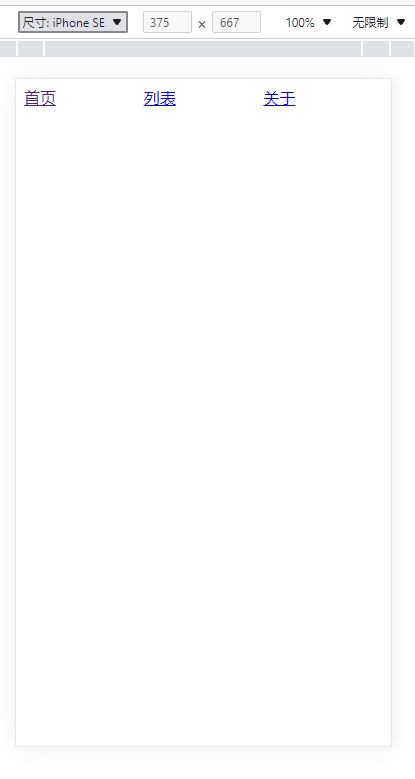
- 修改 src/views/HomeView.vue
<template>
<div class="home">
<h2>Home</h2>
</div>
</template>
<script>
export default {
name: 'HomeView',
components: {
}
}
</script>
- 修改 TabBar 组件 样式表
<template>
<div id="tabbar">
<!-- 因为要设置css,所以再加一层div -->
<div class="tabbar-box">
<router-link class="item" to="/home">首页</router-link>
<router-link class="item" to="/list">列表</router-link>
<router-link class="item" to="/about">关于</router-link>
</div>
</div>
</template>
<script>
export default {
}
</script>
<!-- 使用scss样式编写(可嵌套) -->
<style lang="scss">
#tabbar{
.tabbar-box{
display: flex;
position: fixed;
left: 0;
right: 0;
bottom: 0;
text-align: center;
height: 49px;
line-height: 49px;
background-color: #efefef;
.item{
// 指每个容器占一份(即可用空间平均分配)
flex: 1;
text-decoration: none;
color: #000
}
// 配置当前页面(这是自带的class)
// .router-link-exact-active{
// color: red;
// }
// 3. 定义样式
.active{
color:green;
background-color: #f00;
}
}
}
</style>
PS: 修改路由:
...
const router = new VueRouter({
mode: 'history',
base: process.env.BASE_URL,
routes,
// 1. 路由里也可以配置当前页面的class
linkActiveClass: 'active'
// 2. 然后到Tabbar.vue中定义样式
})
...
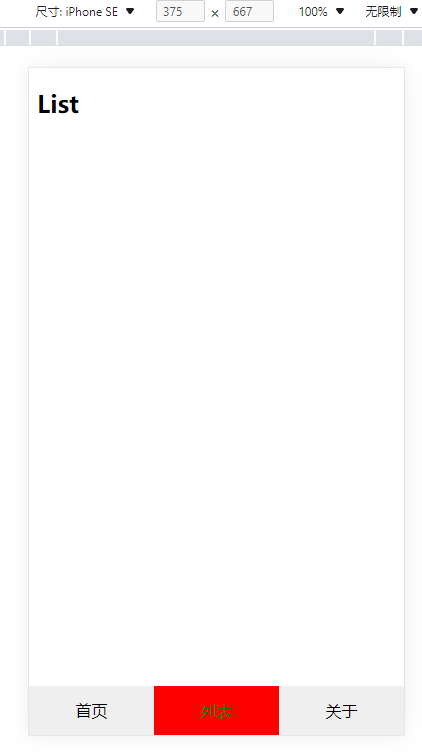
路由嵌套
在 Home.vue 中加入新闻、消息模块,并添加router-view显示区域
<template>
<div class="home">
<h2>Home</h2>
<router-link>新闻</router-link>
<router-link>信息</router-link>
<router-view></router-view>
</div>
</template>
<script>
export default {
name: 'HomeView',
components: {
}
}
</script>
在 components/Home 中新建 Home.vue 和 Message.vue
<template>
<div>
<ul>
<li>新闻</li>
<li>新闻</li>
<li>新闻</li>
<li>新闻</li>
<li>新闻</li>
</ul>
</div>
</template>
<script>
export default {
}
</script>
<style>
</style>
<template>
<div>
<ul>
<li>消息</li>
<li>消息</li>
<li>消息</li>
<li>消息</li>
<li>消息</li>
</ul>
</div>
</template>
<script>
export default {
}
</script>
<style>
</style>
修改 HomeView.vue
<template>
<div class="home">
<h2>Home</h2>
<!-- 注意 to 路径 -->
<router-link to="/home/news">新闻</router-link> |
<router-link to="/home/message">信息</router-link>
<router-view></router-view>
</div>
</template>
<script>
export default {
name: 'HomeView',
components: {
}
}
</script>
在 router/index.js 的 home路由中设置子路由
// 设置home的路由
{
path: '/home',
component: HomeView,
// 设置子路由,让News和Message显示在Home下面
children: [
// 添加根路径,让子路由自动显示“News”
{ path: '', redirect: 'news' },
// 注意 path 不需要 "/"
{ path: 'news', component: News },
{ path: 'message', component: () => import('../components/Home/Message.vue') }
]
},
效果:
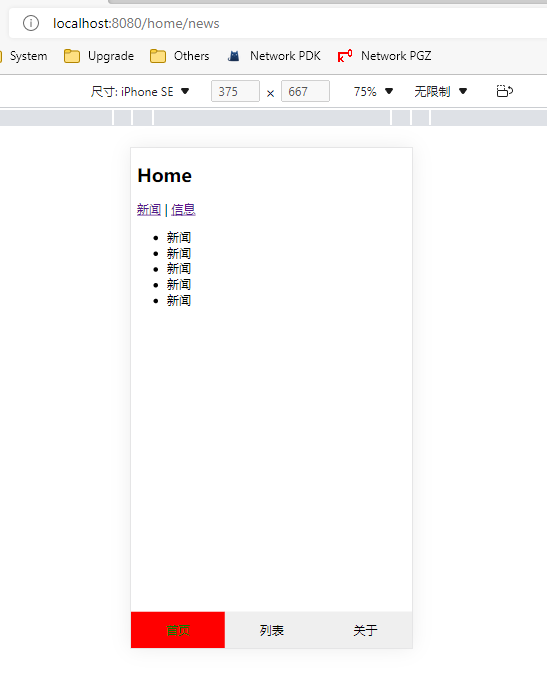
*:此项目在Vuex中扔继续使用
